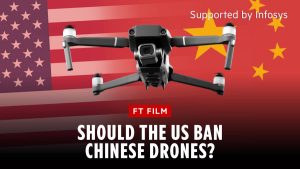The conflicted investment case for defence tech
Stay informed with free updates
Simply sign up to the Technology myFT Digest — delivered directly to your inbox.
It is hard enough building a successful start-up at the best of times. But these are decidedly not the best of times for Viktoriia Yaremchuk, co-founder of the Lviv-based start-up Farsight Vision. Electricity blackouts, missile strikes and sudden conscription of her employees add extreme jeopardy to Yaremchuk’s mission. “Working underground is not that cool. We are not in a garage in Silicon Valley, but a cellar in Ukraine,” she tells me.
Yaremchuk’s company, which provides situational awareness software for drones, is one of scores of Ukrainian start-ups that are helping their country defy Russia’s invasion. They are also adding a new dimension to warfare as they rapidly innovate in response to feedback from the front line and raise money from venture capital firms and rich donors to boost the country’s overall defence spending. This privatisation of war is being closely followed by Nato members, helping to trigger a surge in defence tech investment across North America and Europe.
Since 2019, VC investment in defence start-ups in Nato countries has increased fourfold, rising to $3.9bn so far this year, according to a Dealroom report released last week. The US accounts for 83 per cent of VC defence tech investment, with EU countries and the UK recording 15 per cent since 2018. Investment in the sector has risen from 0.4 per cent of VC funding in Europe in 2022 to 1.8 per cent this year.
The investment case for defence tech was made by several company founders and VCs at the Resilience Conference in London last week. The urgent need to defend democracy has drawn many mission-driven entrepreneurs into the field. Many such start-ups are also creating dual-use technologies, enabling them to tap into civilian markets.
Farsight’s drone software, for example, can be used in the mining, energy and logistics industries. Increased defence spending from Nato governments provides a strong monetary magnet. And Nato has set up its own €1bn innovation fund to support defence tech start-ups. War, it seems, is in a bull market.
Magnus Grimeland, founder of the global early-stage VC fund Antler, says weapons systems are undergoing a platform shift as they become “smaller, cheaper and more connected”. If democratic societies want to defend themselves from hostile powers, then it is a “necessity” to support start-ups that are often the most capable of developing such software-enabled weapons systems.
“Unless some of the best innovators in the world are innovating in this field we are not going to win,” the former Norwegian special forces officer tells me.
But many investors remain deeply wary of defence tech, which they suggest is now in bubble territory. To thrive longer term, start-ups will need more capital, streamlined regulation and faster procurement processes. “The returns are no higher than other sectors, and the risks are much greater,” says one investor.
Many institutional funds and VCs are barred from investing in defence tech because of ESG (environmental, social and governance) concerns. Defence tech champions have made a persuasive case that defending democracy is a priceless governance good, the ultimate G. But investing in weapons, just like tobacco, coal and gambling, remains off-limits for many fund managers.
“Some investors do not want to go beyond the ‘kinetic line’ and build tech that kills people,” one investor told the Resilience Conference.
At a separate closed-door meeting of defence tech investors I attended last week, some fund managers expressed additional concerns about how dual-use technologies developed by their portfolio companies might be employed by the military in emergencies. The danger of “ethics creep” is real.
Some company founders also despair of dealing with slow-moving, bureaucratic defence ministries that are far happier to buy from established defence companies than chancy start-ups. But, as one public sector investor says, governments are slow for a reason. They want to be certain that the new life-and-death technologies do not cause collateral risks to their own armed forces or civilian populations.
The urgency of war accelerates that process, as in Ukraine. The example of Farsight Vision shows how defence tech companies can innovate fast and help defend sovereignty while offering the possibility of making money for investors. “Three years ago, I would never have dreamt that I would work in this field. But I am very proud of doing what we are doing. I think our business has a lot of potential in lots of other spheres of life,” Yaremchuk says.
#conflicted #investment #case #defence #tech







